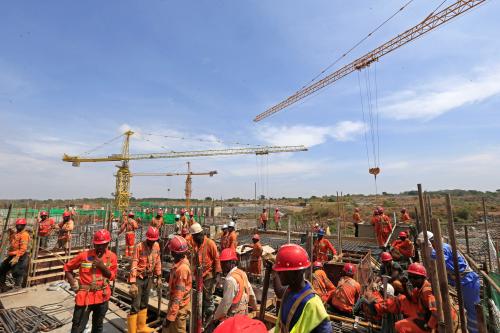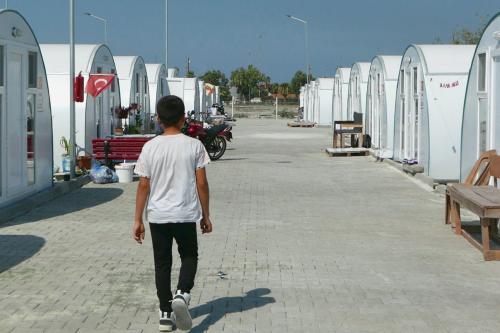The stars—or at least the policies and politics—are aligning for a concerted and coherent U.S. approach to fragility, an underlying cause of state instability, poverty, and violence.
Two seminal and companion new policy proposals are in the offing. Today, February 26th, sees the release of the final report of the Task Force on Extremism in Fragile States, mandated in the FY 2017 appropriations bill and mentored at the U.S. Institute of Peace. Shortly afterward, members in the House and Senate are expected to introduce new versions of legislation from the last Congress, H.R. 5273 (which passed the House in 2018) and S. 3368, the Global Fragility and Violence Reduction Act.
Both the report and the legislation cut across the political divide. The bills are sponsored by members from both political parties. The Task Force is comprised of former (and one current) senior policymakers who served both Democratic and Republican administrations and who are still very much engaged in informing U.S. foreign policy. (My colleague Homi Kharas and I serve as Senior Advisors to the Task Force.)
The synergy doesn’t stop with the Congress and this independent task force; it also includes the executive branch. Administration officials from relevant agencies were consulted by the Task Force, and recent administration policy statements—the Stabilization Assistance Review and the National Security Strategy—acknowledge the critical importance of dealing with violence and fragility.
The Task Force report, as well as the legislation, targets what has been absent from the U.S. policy approach—a prevention strategy. This approach seeks to head off fragility before it builds into instability and extremism, monitoring and assessing in-country dynamics to identify circumstances that, if left to fester, could fuel instability and extremism.
The Task Force recommends three initiatives.
First comes a “shared framework”—a U.S. government strategy that is common to all relevant U.S. government departments and agencies so there is a coordinated, consistent U.S. approach to violence and fragility.
Second, operating within that framework would be a Strategic Prevention Initiative, comprising coordinated diplomatic, economic, and security programs supported by funding that can be adapted to evolving conditions. The Department of State would lead the diplomatic aspect of the initiative, USAID the economic assistance portion, and the State Department and Department of Defense the security element.
The third initiative would be a new international Partnership Development Fund, an in-country finance and coordination platform structured to provide donors with the flexibility to work with local communities and leaders to support and align programs. The platform would be designed to coordinate comprehensive, long-term approaches and have an inclusive governance structure comprised of donors, host government, and civil society.
The House and Senate bills, assuming they remain similar to last year’s legislation, will include what are essentially the first two initiatives. The third, the in-country platform, would be an appropriate addition.
What particularly stands out in the report of the Task Force is the focus on the how not the what. This parallels the manner in which the legislation is drafted. Both deserve a huge shout out for being built on learned lessons.
Both the report and the bills acknowledge that there are no pat answers to the what in dealing with fragility. Neither offers a simple set of activities. The relevant programs will vary with each country situation. The what will be known only after careful analysis of the specific context and will change with monitoring as circumstances change.
What is known, from several decades of development experience, is the how, and that is clearly laid out in the report and built into the legislation. First and foremost, answers must be homegrown. Localization is the mantra—the right solutions cannot be imposed from outside. They must be based on the priorities of the community and its leaders, and local actors must play a central part in the design and implementation of programs. External donors can support activities, but they must be locally driven. Only local actors know the landscape and how to maneuver in the culture and have the necessary connections and networks.
Beyond that, managers must have the authority to fit activities to local conditions, which often change, so activities must be adjusted to meet evolving circumstances. Development is by nature dynamic. What worked in one country or province may not work in another; what worked last year may not work next year. The ability to adapt programs is critical to their relevance and effectiveness.
Accountability must be built into programs. Accountability encompasses monitoring, evaluation, transparency, and learning. Continuous monitoring informs managers whether an activity is being implemented properly and whether it remains relevant or needs adjustment. Evaluation produces lessons that can be turned into knowledge and inform subsequent programs. Transparency allows everyone to look into the project—so it is accountable to local and donor stakeholders, so local officials can mesh an activity with local programs and budgets, and so other donors don’t duplicate and can coordinate with and build on it.
Programs must be inclusive. Fragility and violence often result from grievances by segments of a community or population that are excluded from political and economic life. Too frequently women and youth are left out, and experiences have demonstrated their relevance to successful solutions.
The most politically sensitive and difficult aspect of the report and the legislation is the call for adaptive programming. The concept of adaptability is widely accepted, as pragmatism and reason argue for programs being relevant to the circumstances. The difficulty comes in the implementation. It means decisionmakers at the White House, State Department, and USAID headquarters must forego the right to control programs, and instead leave it to their lieutenants in the field to work with local actors to design and manage programs. It means the Congress, always wary of any administration’s ability to circumvent its intent and keep it in the dark, must forgo predetermining what assistance will be used for—forgoing earmarks and directives on assistance for fragile environments.
The bills from last year dealt with this issue through language encouraging “exemption from specific and minimum funding levels.” An alternative approach would be to authorize flexibility in how funds are utilized.
There are several ways in which this difficulty can be managed. Ambassadors, USAID mission directors, and their senior staff should be selected from a cadre of career foreign service officers who are trained and experienced in operating in fragile environments, and whose knowledge and authority will be respected by their colleagues in Washington. The State Department and USAID need to offer the Congress a level of transparency that will keep key members of Congress and staff fully and timely informed about how diplomatic efforts and assistance programs are functioning—the bad along with the good. Congress might consider the suggestion in the Task Force report to create a bipartisan, bicameral oversight working group comprised of members of relevant committees.
The last Congress enacted on a bipartisan basis nearly a dozen bills dealing with development and foreign assistance, most notably the BUILD Act to modernize U.S. development finance capabilities, which includes prioritizing fragile states. Like that legislation, fragility is receiving bipartisan and bicameral attention and endorsement, and civil society organizations are advocating for the approach set forth in the Task Force report and the legislation. The Stability Act could be the BUILD Act of the 116th Congress.







Commentary
A pragmatic approach to violence and state fragility
February 26, 2019